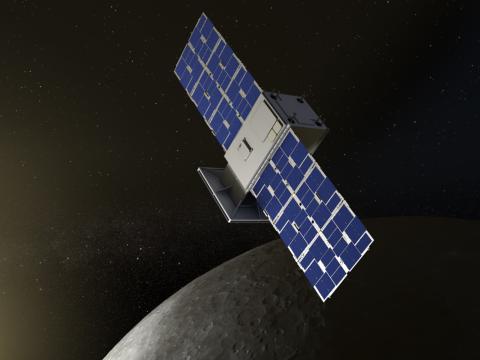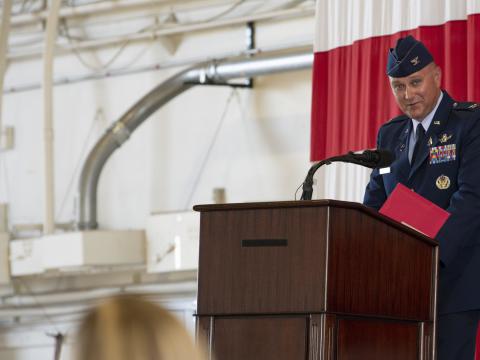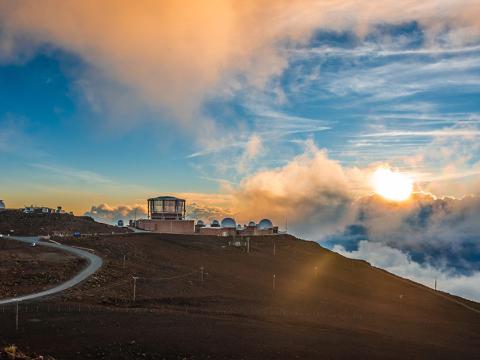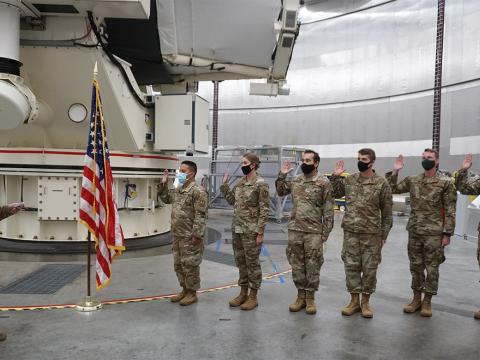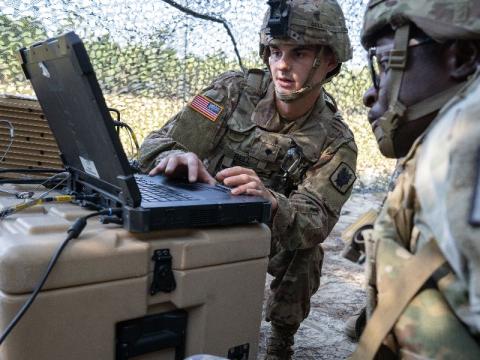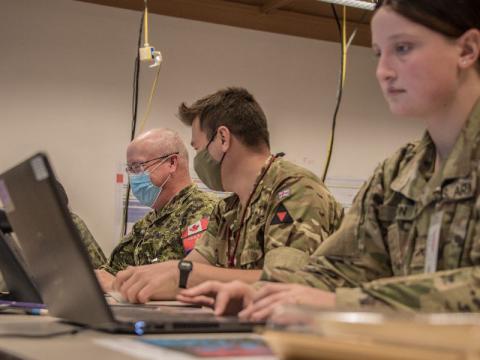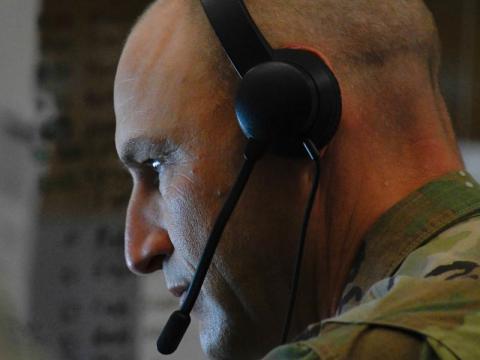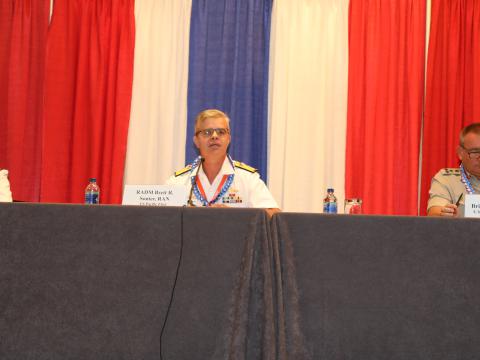 |
| Approximately 300 Airmen and six Japan Air Self-Defense Force (JASDF) liaison officers participate in the bilateral command post exercise Keen Edge, an annual weeklong joint bilateral exercise to increase combat readiness and interoperability for the 13th Air Force and JASDF. The JASDF is relocating its Air Defense Command to Yokota Air Base to further strengthen the U.S.-Japanese alliance. |
Alliance grows stronger with major relocation.
The U.S. and Japanese militaries are reaffirming their commitment to collaboration with the construction of a Japanese air defense command on a U.S. Air Force base in the Asian country. The move further enhances the bilateral relationship the two nations share and will increase command and control through persistent personal interaction.
The Japan Air Self-Defense Force (JASDF) is relocating its Air Defense Command (ADC) Headquarters from Fuchu Air Station to Yokota Air Base as a result of the Defense Policy Review Initiative. The move was also directed by the Japan-U.S. Security Consultative Committee’s Japan-U.S. Roadmap for Realignment Implementation in May 2006. The ADC relocation, and subsequent training, will strengthen interoperability, and it will create a tighter partnership between two key allies through information sharing and coordination.
The command headquarters and associated units—a total of approximately 1,200 personnel—will transfer to the new location, considerably improving Japanese and U.S. military-to-military relations. “We have solid relationships already due to significant bilateral efforts to travel between these locations, but having the ADC right next door will help shore up our relationships due to an increase in the daily face-to-face interaction,” explains Col. Michael A. MacWilliam, USAF, commander of 13th Air Force Detachment 1 at Yokota.
Thirteenth Air Force, based in Hawaii, is the Air Force organization responsible for the execution of air operations in the Pacific. Detachment 1 was established as part of 13th Air Force in January 2007 to engage with the JASDF on all operational issues. “Essentially we are 13th Air Force liaisons to the JASDF and will sit side by side with the ADC during exercises and contingencies to coordinate operations,” Col. MacWilliam says.
The two nations’ militaries are not organized as a coalition or as a combined force. Rather, they support a bilateral relationship with separate and distinct command and control and chains of command. “The key to success in the execution of operations in this type of relationship is daily, persistent coordination at all levels,” the colonel says. “The move to Yokota will significantly enhance our command and control coordination.” Though U.S. command and control is not directly affected, the improved coordination of bilateral air and missile defense in the region made possible by the ADC headquarters move is expected to increase effectiveness.
The JASDF and the Air Force already work together regularly. From training exercises to daily interaction between the joint staff and the headquarters of U.S. Forces Japan, some type of communication is a constant. While the exact number of U.S. personnel who will work in the headquarters is still undecided, the personal interactions among members of the two nations are expected to increase and build upon the strong relationships fostered from the current relations.
Because of the two-pronged nature of the alliance, coordination is a key aspect as forces prepare to execute all types of missions such as humanitarian assistance and disaster relief, as well as operations in defense of Japan. “In a sense, the main benefit of the ADC move is a strengthening of the alliance—a stabilizing force in the Pacific,” Col. MacWilliam says.
In addition to the ADC relocation, the Defense Policy Review Initiative directed several other efforts to realign forces in Japan to enhance coordination and information sharing and to improve U.S. and Japanese interoperability. The ADC Headquarters move to Yokota achieves all the objectives and provides U.S. troops in Japan and the Pacific with improved Air Force-JASDF command and control operations during the planning and execution of all bilateral air operations. “This project is vitally important to the continued strengthening of the Japan-U.S. bilateral security relationship,” explains Maj. Hiroaki Akiguchi, assistant of the spokesperson of the JASDF.
The ADC Headquarters is the supreme Self-Defense Force command authority for Japanese air defense and serves as the headquarters for ballistic missile defense as well. An air defense system called the Japan Aerospace Ground Environment and advanced communication systems will be used by the command when the relocation is complete.
The ADC move is totally funded by the government of Japan at a cost of approximately $400 million. However, the United States will assist in the planning force and facility laydown at Yokota. The new headquarters facility will house an operations center designed for bilateral coordination. Last year, the JASDF approached the Air Force regarding appropriate bilateral interaction and operations center layout. The ADC incorporated U.S. recommendations regarding connectivity and facility design to ensure timely and accurate coordination between it and the 613th Air and Space Operations Center (AOC) at Hickam Air Force Base, Hawaii. U.S. personnel have a role in assisting in that design and ensuring that the center has adequate connectivity with the 613th AOC.
The details of U.S. troop involvement in the up-and-running center are still being worked out; however, training opportunities, liaisons and interoperability will be increased for all parties. One part of the interoperability challenge that must be overcome is the language barrier. To nullify that problem, both sides use technology and old-fashioned language training to facilitate an effective exchange of information.
Collaboration and coordination will be conducted via a variety of unclassified and bilateral classified systems. Mutual interoperability involving communications and computers will ensure effective operations for the full spectrum of missions and efforts involving the two countries’ militaries.
According to Maj. Akiguchi, the Japanese, as do the Americans, believe that their working relationship will grow stronger as the ADC relocation is implemented. JASDF and Air Force members will work together in the new headquarters to look at a common operational picture. He adds that Japanese and U.S. airmen will work alongside one another, deepening mutual understanding not only of the operational sphere but also of the cultural sphere.
In addition to the ADC Headquarters, the BilateralJointCoordinationCenter will be located at Yokota. The center will perform a function to facilitate bilateral actions for the defense of Japan by enabling close coordination between headquarters Self-Defense Force and U.S. forces. It also will improve interoperability by allowing the Self-Defense Force and U.S. troops to share the same information. The coordination center involves work with air defense and ballistic missile defense.
Another step toward strengthening U.S.-Japanese relations is the collocation of an air and missile defense coordination center with the headquarters of U.S. Forces Japan. This move is central to the continuing success of information sharing and coordination between the United States and Japan. The center will incorporate robust communications and a comprehensive common operating picture to make the two partner militaries more capable and to enable them to maintain security better in the Pacific region.
Improving and fortifying the U.S.-Japanese military relationship is important for Japan’s defense as well as for operations in the larger Pacific. The two nations share certain ideals and benefit from shared resources. According to U.S. Forces Japan, “Japan is a committed ally and partner—there is no more important partner in this region that enhances regional stability. We have the same democratic values: respect for human rights and rule of law, free and fair trade.”
In addition, Japan is the world’s second largest economy, offering financial and technological resources to security in the region and internationally. The Asian nation also has a strategic location that enables defense of critical ocean trade routes and places U.S. forces within minutes or hours of regional flashpoints.
Despite the intrinsic value of location and proximity, transforming and maintaining a strong alliance extends beyond the issue of real estate. According to U.S. Forces Japan, defining the capabilities of each partner and then developing those strengths through bilateral training and collocation cements a proficient alliance. Some focus areas include: missile defense, countering proliferation of weapons of mass destruction, bilateral training and exercises and strengthening Japan’s role in regional and global affairs.
Web Resources
Japanese Air Self-Defense Force: www.mod.go.jp/asdf/en/index.html
U.S. Forces Japan: www.usfj.mil
Yokota Air Base: www.yokota.af.mil

